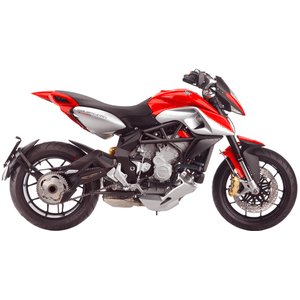MV Agusta Rivale 800 (2013–2018): A Symphony of Italian Passion and Precision
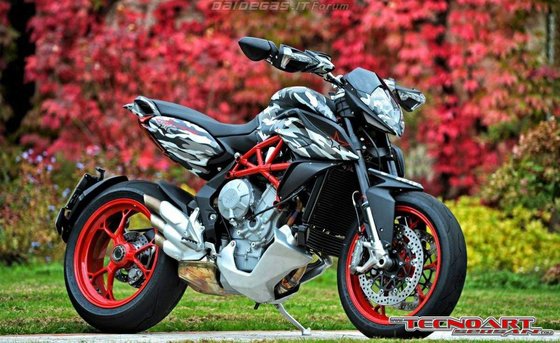
Introduction
When MV Agusta introduced the Rivale 800 in 2013, it wasn’t just launching a motorcycle—it was unleashing a statement. Crowned “the most beautiful bike” at the Milan Motorcycle Show, the Rivale 800 blended avant-garde design with razor-sharp performance, all wrapped in a package that screamed Italian flair. Over its production run until 2018, this machine remained a testament to MV Agusta’s obsession with engineering artistry. But the Rivale isn’t just a pretty face—it’s a 125 HP, 178 kg (392 lbs) thrill generator that redefined what a naked bike could be. After a spirited test ride, here’s why this motorcycle still feels like a revelation.
Design: Aggression Meets Elegance
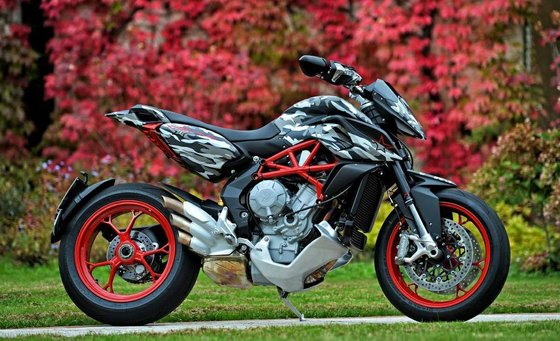
The Rivale 800’s design is a masterclass in controlled chaos. Its angular bodywork, exposed trellis frame, and sculpted single-sided swingarm create a visual tension that’s both futuristic and deeply mechanical. The Urban Camo Special Edition—commissioned by none other than Claudio Castiglioni—took this aggression further with a militaristic gray/white/black livery, proving the Rivale could wear any outfit and still steal the show.
Key design highlights:
- LED Lighting: The front LED “blades” and floating rear taillight weren’t just stylish—they increased visibility dramatically.
- Ergonomics: With a seat height ranging from 810 mm (31.9") to 881 mm (34.7"), the Rivale catered to shorter and taller riders alike. The narrow midsection and wide bars gave a commanding, yet agile riding position.
- Materials: From the aluminum alloy wheels to the Brembo brake calipers, every component felt purpose-built.
This wasn’t a motorcycle that blended in—it demanded attention at every stoplight.
Engine and Performance: The Heart of a Racebike
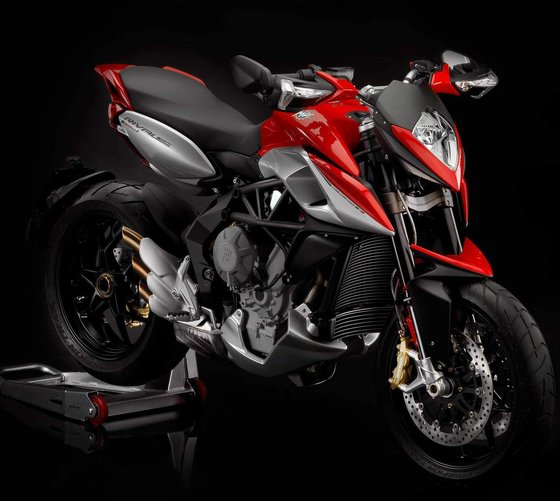
At the core of the Rivale 800 lies a 798 cc inline-three cylinder engine—a masterpiece that revved to 13,000 RPM and delivered 125 HP (92 kW) and 84 Nm (62 lb-ft) of torque. The counter-rotating crankshaft (a trick borrowed from MV’s F3 supersport) reduced gyroscopic effects, making the bike feel lighter than its 178 kg (392 lbs) dry weight.
Riding Impressions:
- Low-End Punch: Despite its high-rev nature, torque surged at 8,600 RPM, pulling hard out of corners.
- Exhaust Note: The triple’s growl—raspy at idle, screaming at full tilt—was pure auditory adrenaline.
- Top Speed: 245 km/h (152 mph) wasn’t just a number; it felt achievable, stable, and addictively smooth.
The MVICS (Motor & Vehicle Integrated Control System) offered three engine maps (Rain, Normal, Sport) and a customizable “Custom” mode, letting riders tailor throttle response and torque delivery. Paired with a slick 6-speed cassette-style gearbox (and optional EAS quickshifter in later models), the Rivale was as docile in traffic as it was unhinged on open roads.
Handling and Dynamics: A Dance Partner for the Twisty Bits
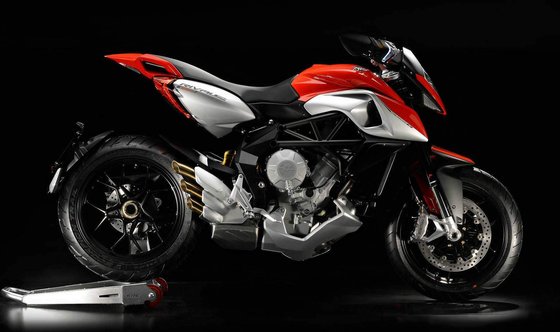
MV Agusta’s steel trellis frame and aluminum swingarm pivot plates gave the Rivale a wheelbase of 1,410 mm (55.5"), striking a balance between agility and stability. The suspension setup—43 mm Marzocchi USD forks (150 mm travel) and a Sachs rear shock (130 mm travel)—was fully adjustable, catering to both canyon carving and weekday commutes.
On the Road:
- Flickability: The Rivale changed direction like a supersport, thanks to its 24.5° rake and 95 mm (3.7") trail.
- Braking: Dual 320 mm Brembo discs with radial calipers up front (and a 220 mm rear disc) offered stoppie-friendly power, aided by ABS in later models.
- Tires: Pirelli Diablo Rosso II rubber (120/70-17 front, 180/55-17 rear) provided grip that inspired mid-corner confidence.
This wasn’t a bike that tolerated lazy riding—it rewarded precision with poise.
Technology and Electronics: Ahead of Its Time
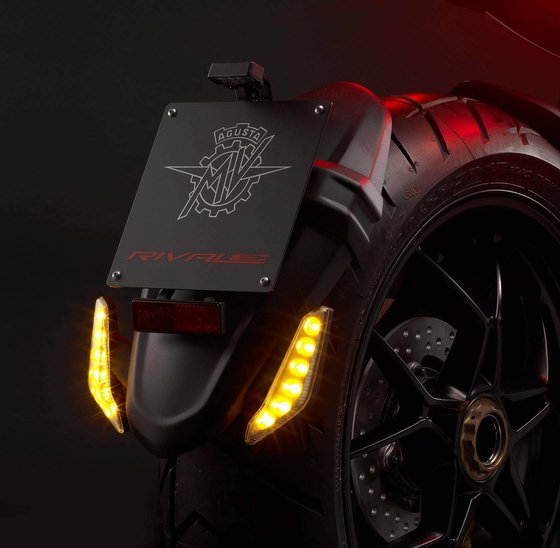
The Rivale’s tech suite was groundbreaking for its era:
- Ride-by-Wire Throttle: Delivered seamless power transitions.
- 8-Level Traction Control: From rain-soaked roads to track days, it kept the rear tire in check.
- RLM (Rear Wheel Lift Mitigation): Prevented unwanted wheelies under hard braking.
- Digital Dashboard: A monochrome display offered gear position, fuel economy, and even a lap timer.
While not as flashy as modern TFT screens, the interface was intuitive, keeping eyes on the road where they belonged.
Competition: How the Rivale Stacks Up
The Rivale 800 faced fierce rivals in the premium naked segment:
| Model | Pros | Cons |
|----------------------|-----------------------------------------------|--------------------------------------------|
| Triumph Street Triple 765 | Smoother triple, lower seat height (825 mm / 32.5") | Less exotic, softer design |
| Ducati Monster 1200 | Brutal 145 HP L-twin, Ducati pedigree | Heavier (209 kg / 461 lbs), higher cost |
| Yamaha MT-09 | Affordable, torquey 847 cc triple | Budget suspension, less premium feel |
The Rivale carved its niche with exclusivity. While rivals focused on practicality, MV Agusta delivered a motorcycle that felt like rolling art—with the performance to match.
Maintenance: Keeping the Italian Fire Alive
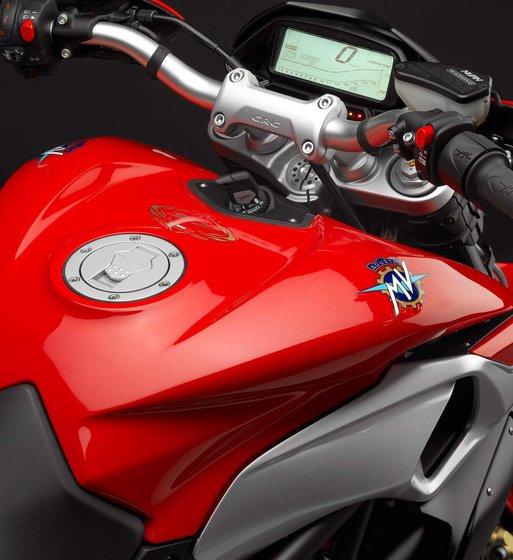
Owning a Rivale 800 is a commitment, but one that rewards diligence:
- Oil Changes: Use fully synthetic SAE 10W-60 every 6,000 km (3,700 miles). The counter-rotating crankshaft demands quality lubrication.
- Valve Adjustments: Every 20,000 km (12,400 miles)—a job best left to specialists familiar with MV’s 4-valve-per-cylinder setup.
- Chain Care: The 525-size chain requires regular cleaning and adjustment to handle the triple’s torque.
- Brake Maintenance: Brembo pads and DOT 4 fluid replacements ensure that stopping power never fades.
MOTOPARTS.store Recommendations:
- Upgrade to sintered brake pads for sharper bite.
- Install a premium aftermarket exhaust to unlock the triple’s full acoustic potential.
- Consider adjustable rearsets for personalized ergonomics during aggressive rides.
Conclusion: A Modern Classic
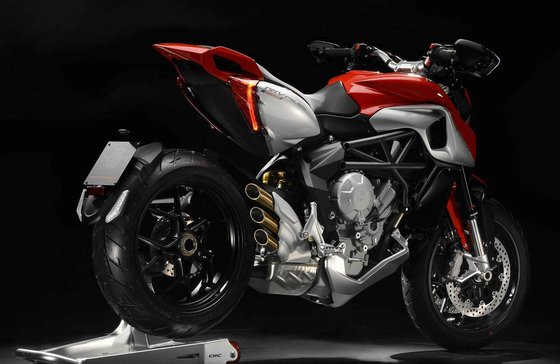
The MV Agusta Rivale 800 wasn’t just a motorcycle—it was a rebellion against compromise. It fused track-derived tech with street-smart versatility, all while looking like it belonged in a Milanese art gallery. Yes, it demanded respect (and occasional wrenching), but for those willing to embrace its quirks, the Rivale delivered an ownership experience as thrilling as its ride.
In a world of cookie-cutter nakeds, the Rivale 800 remains a reminder that passion, when engineered to perfection, is timeless.
Specifications sheet
| Engine | |
|---|---|
| Stroke: | Four-stroke |
| Ignition: | Motor & Vehicle Integrated Control System (MVICS) |
| Max power: | 92 kW | 123.0 hp |
| Max torque: | 84 Nm |
| Fuel system: | Fuel Injection (MVICS with Full Ride-By-Wire) |
| Max power @: | 12000 rpm |
| Displacement: | 798 ccm |
| Max torque @: | 8600 rpm |
| Bore x Stroke: | 79.0 x 54.3 mm (3.1 x 2.1 in) |
| Configuration: | Inline |
| Cooling system: | Liquid-cooled |
| Compression ratio: | 13.3:1 |
| Number of cylinders: | 3 |
| Valves per cylinder: | 4 |
| Dimensions | |
|---|---|
| Wheelbase: | 1410 mm (55.5 in) |
| Dry weight: | 178 |
| Seat height: | 810–881 mm (31.9–34.7 in) adjustable |
| Overall width: | 885 mm (34.8 in) |
| Overall length: | 2070 mm (81.5 in) |
| Ground clearance: | 142 mm (5.6 in) |
| Fuel tank capacity: | 16.6 L (4.3 US gal) |
| Drivetrain | |
|---|---|
| Final drive: | chain |
| Gear ratios: | 1st: 13/37, 2nd: 16/34, 3rd: 18/32, 4th: 19/30, 5th: 21/30, 6th: 22/29 |
| Transmission: | 6-speed, cassette-style |
| Rear sprocket: | 41 |
| Front sprocket: | 16 |
| Electronics | |
|---|---|
| Engine maps: | 3 preset + 1 customizable |
| Instrumentation: | Monochrome digital display with gear indicator and diagnostics |
| Throttle system: | Full Ride-By-Wire |
| Traction control: | 8-level adjustable |
| Maintenance | |
|---|---|
| Coolant: | Water-based ethylene glycol |
| Chain type: | 525 pitch |
| Engine oil: | SAE 10W-60 API SG+ |
| Break fluid: | DOT 4 |
| Spark plugs: | NGK CR9EIB-9 |
| Alternator output: | 350W @ 5000 RPM |
| Valve clearance check interval: | 24,000 km (15,000 mi) |
| Chassis and Suspension | |
|---|---|
| Frame: | Steel trellis with aluminum alloy plates |
| Wheels: | Aluminum alloy with Pirelli Diablo Rosso II tires |
| Rear tire: | 180/55-z-17 |
| Front tire: | 120/70-z-17 |
| Rear brakes: | Single 220 mm disc, Brembo 2-piston caliper (ABS on some models) |
| Front brakes: | 2 x 320 mm discs, Brembo 4-piston radial calipers (ABS on some models) |
| Rear suspension: | Sachs monoshock, adjustable rebound/compression damping and preload |
| Front suspension: | 43mm Marzocchi USD fork, adjustable rebound/compression damping and preload |
| Rear wheel travel: | 130 mm (5.1 in) |
| Front wheel travel: | 150 mm (5.9 in) |



